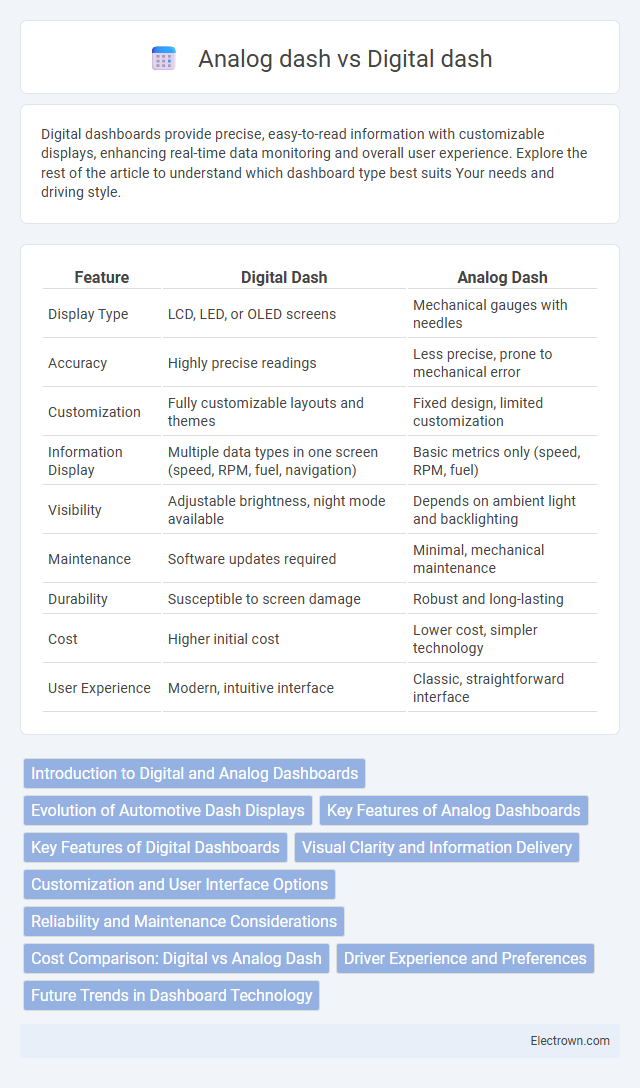Digital dashboards provide precise, easy-to-read information with customizable displays, enhancing real-time data monitoring and overall user experience. Explore the rest of the article to understand which dashboard type best suits Your needs and driving style.
Table of Comparison
| Feature | Digital Dash | Analog Dash |
|---|---|---|
| Display Type | LCD, LED, or OLED screens | Mechanical gauges with needles |
| Accuracy | Highly precise readings | Less precise, prone to mechanical error |
| Customization | Fully customizable layouts and themes | Fixed design, limited customization |
| Information Display | Multiple data types in one screen (speed, RPM, fuel, navigation) | Basic metrics only (speed, RPM, fuel) |
| Visibility | Adjustable brightness, night mode available | Depends on ambient light and backlighting |
| Maintenance | Software updates required | Minimal, mechanical maintenance |
| Durability | Susceptible to screen damage | Robust and long-lasting |
| Cost | Higher initial cost | Lower cost, simpler technology |
| User Experience | Modern, intuitive interface | Classic, straightforward interface |
Introduction to Digital and Analog Dashboards
Digital dashboards use electronic displays to present real-time vehicle data such as speed, fuel level, and engine status with high precision and customizable layouts. Analog dashboards feature mechanical gauges with physical needles to indicate metrics, offering classic aesthetics and immediate visual feedback. Modern vehicles increasingly combine both systems, blending digital accuracy with traditional design elements for enhanced driver information.
Evolution of Automotive Dash Displays
Digital dash displays have transformed automotive interiors by replacing traditional analog gauges with customizable, high-resolution LCD or OLED screens, offering dynamic interfaces that adapt to driving conditions in real-time. The evolution from analog dials to digital instrument clusters enhances driver information accuracy, integrates advanced data such as navigation, fuel efficiency, and vehicle diagnostics, and supports connectivity with smartphones and onboard systems. This shift reflects broader automotive trends toward smart cabin technology, improving usability, safety, and vehicle personalization.
Key Features of Analog Dashboards
Analog dashboards feature physical gauges with needle pointers that provide real-time readings of vehicle parameters such as speed, fuel level, and engine temperature. Their design offers high visibility and quick interpretation through intuitive scale markings and tactile feedback, which enhances driver focus and safety. Unlike digital displays, analog dashboards function without reliance on electronic interfaces, ensuring reliability under various driving conditions.
Key Features of Digital Dashboards
Digital dashboards feature customizable, real-time data displays with interactive touchscreens allowing users to access various metrics and alerts instantaneously. Their integration with telematics systems offers advanced diagnostics, GPS navigation, and multimedia controls, enhancing vehicle monitoring and user experience. Unlike analog dashboards, digital systems provide greater precision, multiple display modes, and the ability to update software remotely for feature enhancements.
Visual Clarity and Information Delivery
Digital dashboards provide superior visual clarity by presenting data through crisp, high-resolution graphics and customizable layouts, enhancing your ability to quickly interpret information. Analog dashboards rely on traditional gauges and needles, which can be harder to read accurately, especially in low-light conditions or when multiple data points compete for attention. The precise, real-time feedback from digital dashes improves information delivery, enabling faster decision-making and a more intuitive user experience.
Customization and User Interface Options
Digital dashboards offer extensive customization options, allowing users to personalize layouts, colors, and display metrics to suit specific preferences or driving conditions. Analog dashboards provide limited customization, primarily featuring fixed gauge designs and physical needle movements that convey speed and engine data intuitively. The user interface on digital dashes is more dynamic, integrating touchscreens and interactive elements that enhance usability compared to the static, traditional analog readouts.
Reliability and Maintenance Considerations
Digital dashboards offer enhanced reliability due to fewer mechanical components, reducing the likelihood of wear and tear compared to analog dashes with physical gauges. Maintenance for digital displays often involves software updates and occasional component replacements, which are typically less frequent but may require specialized technicians. Your choice should consider the ease of diagnosing issues and the overall durability needed for consistent performance.
Cost Comparison: Digital vs Analog Dash
Digital dashboards generally have higher upfront costs due to advanced technology and complex integration with vehicle systems, while analog dashboards are more affordable and simpler to manufacture. Maintenance and repair expenses tend to be higher for digital dashboards owing to specialized components and software updates, whereas analog dashboards require less costly mechanical repairs. Over time, digital dashes may offer cost benefits through enhanced functionality and customizable displays, potentially reducing expenses related to driver information and diagnostics.
Driver Experience and Preferences
Digital dash offers customizable displays that provide real-time data, enhancing your driving experience with clarity and precision. Analog dash gauges deliver intuitive, easy-to-read feedback, preferred by drivers who value traditional, tactile interfaces. Driver preferences often depend on familiarity and the level of information desired, balancing modern technology with classic simplicity.
Future Trends in Dashboard Technology
Digital dashboards are rapidly evolving with advancements in AI, augmented reality, and real-time data integration, providing more interactive and customizable displays than traditional analog dashboards. Future trends highlight enhanced connectivity, seamless integration with smart devices, and improved user interfaces designed to deliver precise analytics and predictive insights. Your driving experience will increasingly rely on these intelligent dashboards to offer safer, more efficient navigation and vehicle management.
Digital dash vs Analog dash Infographic

 electrown.com
electrown.com